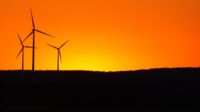Rim Rock Wind Farm Is Largest-Capacity Wind Site in Montana












The top of an escarpment in northern Montana was selected for the $370-million Rim Rock Wind Farm because of its year-round strong winds. But the same winds that propel the turbine blades caused some of its biggest construction challenges.
Other difficulties in building the state's single largest-capacity wind project included the bitter cold and accommodating golden eagles and other raptors that live in the Rim Rock area near Cut Bank, Mont.
Rim Rock faced weather problems because major construction had to be completed by year-end 2012 so that the owner, NaturEner USA LLC, could take advantage of the expiring federal production tax credit for wind energy. Meeting that deadline required the start of limited construction—cutting roads and setting up staging areas—in October 2011 and full construction in January 2012. The time frame also meant dealing not only with winds of 25 to 30 miles an hour but also subzero temperatures, snow and ice. Sometimes concrete for the turbine foundations was poured during blizzards.
"There would be guys standing there with vibrators, pouring concrete with snow coming down sideways," says Gregory Copeland, vice president of wind energy development at San Francisco-based NaturEner USA, a subsidiary of European energy conglomerate Grupo NaturEner S.A. of Spain, as well as at the parent's Canadian branch.
"The winter weather in north-central Montana—we were only 15 miles from the Canadian border—gets cold. We had to heat concrete and rebar," says Kevin Deters, vice president and general manager at Mortenson Construction Renewable Energy Groups, Minneapolis, Rim Rock's general contractor. "It was not uncommon to have days below zero. We had to find ways to work safely in that environment."
The contractor performed elaborate wind forecasting, for example, so wind speeds would be relatively low when the cranes lifted components for turbine tower assembly. "In the 18 years we've done this, we've never lost a turbine component, and we've done close to 10,000 pieces total," Deters says.
Mortenson even heated the ground where concrete would be poured and covered jobsites with large tarps to keep the snow off. "We had these massive infield baseball tarps in place," says Steve Cook, Mortenson construction executive on the project. "We don't do that on every project."
Tax Credits
The production tax credit (PTC) for wind and other renewable energy projects, which was supposed to end last year, was ultimately extended by the American Taxpayer Relief Act of 2013 and is now set to expire at the end of this year.
Mortenson completed construction on Rim Rock's 126 turbines in October, in time for testing and commissioning before year-end. Commercial operations began in late December. Montana weather was finally good enough in the spring for crews to start restoring the Rim Rock site—reseeding collection trenches, removing the laydown yard and other tasks—for final completion in June. Peak construction, with roughly 320 contractor employees on site, occurred last summer.
Located on 21,000 acres near NaturEner's Glacier I and 2 wind projects in Montana, Rim Rock's turbines, made by Acciona S.A. of Spain, can generate 189 MW of energy at full capacity, enough electricity to power 60,000-plus homes. Each turbine tower stands 262 ft tall and weighs about 500,000 lb, with three blades, each measuring 118 ft long. Both Mortenson and Rim Rock electrical contractor EPC Services Co., Billings, Mont., also worked on Glacier 1 and 2, with 106.5 MW and 103.5 MW of capacity, respectively.
In addition to the turbines, Rim Rock includes two collector substations, nine power-collection circuits, a 5,000-sq-ft operations and maintenance building and two generation tie-lines connecting the collector substations to the regional transmission grid.
The project has a 25-year deal to sell its energy to San Diego Gas & Electric Co. (SDG&E), transmitting it through the 214-mile Montana-Alberta Tie Line to several Western U.S. states and the Canadian provinces of Alberta and British Columbia. After years of delays, cost overruns and lawsuits, the MATL is scheduled to be fully operational by July 1.
NaturEner initially envisioned Rim Rock's capacity at 309 MW from 206 turbines, but the owner cut the project's capacity in mid-2011 to get a $285-million tax-equity capital contribution from SDG&E. The funding required California Public Utilities Commission (CPUC) approval, but that was challenged by watchdog groups worried about the wind project's cost to ratepayers at the higher capacity. To mollify ratepayers and win CPUC approval, Rim Rock's capacity was reduced to its current 189 MW.
As Mortenson installed the turbines, EPC Services connected the towers with nearly 50 miles of underground cable for power generation and ran fiber-optic cable for communications. Each turbine has a small weather station on top to monitor winds and tell the turbine when it is in position to capture optimum wind power.
"Mortenson was bringing in 10 towers a week and erecting two a day," says Lynn Larson, general manager at EPC Services. "We had to be right behind them with grounding and starting the wiring. Once a tower was erected, we had two to three days to get it powered."










